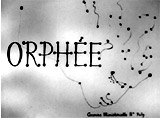
|
Orphée (1950, Fr.) (aka Orpheus)
In Jean Cocteau's visually-beautiful, eccentric, surreal,
romantic fantasy drama set in post-war 1950s Paris - a retelling
of the classic Greek Orpheus myth (about a musician's descent into
the underworld to reclaim his dead wife) -- the avante-garde film
was part of Cocteau's Orphic Trilogy (The Blood of a Poet (1930,
Fr.), and Testament of Orpheus (1960, Fr.)):
- the title character: the light-haired, famous, handsome
and popular Left Bank existentialist, middle-aged poet Orphée
or Orpheus (Jean Marais), obsessed with Death, who was married
to beautiful but unhappily neglected and pregnant wife Eurydice
(Marie Déa)
- in the opening scene, Orphee was in the Café des
Poètes (Poet's Cafe) in modern-day Paris, talking about how
younger resentful poets scorned his success; a black Rolls Royce
pulled up outside commanded by the Princess (Maria Casares); it was
driven-chauffeured by her assistant Heurtebise (François Périer)
- later revealed to be a man who had recently committed suicide by
gassing himself to death; a drunken poet rival, Jacques Cégeste
(Édouard Dermithe), patronized by the Princess, emerged from
the car
- a brawl broke out inside and outside the cafe, and
Cegeste was struck and killed by two motorcyclists on the street
during the chaos
- the Princess - representing, depicting and personifying
Death (revealed later), ordered the transport of Cegeste's corpse
in the Rolls Royce parked outside, and firmly urged Orphee to accompany
them as a 'witness'; the first of many cryptic radio messages was
heard:
"Silence. Goes faster backwards. Three times. Your attention please:
A single glass of water lights up the world"
- after dark, the car was escorted by the Princess'
two henchmen: male, helmeted motorcycle riders dressed in black leather
and wearing high boots - they were responsible for Cegeste's death
The Princess with Rolls Royce's Chauffeur Heurtebise
- A Death Vehicle
|
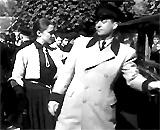
|

|
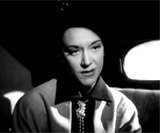
|
- the car was driven to the ruins of an abandoned
chateau, where the Princess magically revived Cegeste from death;
he and the Princess passed into the Underworld (through a mirror),
but Orphee was unable to follow after them; after returning home,
Orphee received cryptic messages from Cegeste's spirit, as well
as nocturnal visitations from the Princess who entered through
his bedroom's mirror and watched him sleep; he sat in the Rolls
Royce in his garage and obsessively listened to the radio that
was broadcasting abstract poetry and coded messages from the afterlife
|
Symbolic, Magical, Dreamlike and Fantasy Elements
|

|
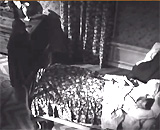
|
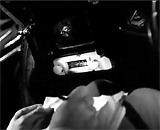
|
|
The Princess Entering Through Orphee's Bedroom
Mirror - A Superimposed Shot
|
At the Foot of His Bed, the Princess Watching
Orphee Sleep
|
Orphee Transcribing Gnomic Messages Delivered
Through the Radio
|
- as the film progressed, a love triangle developed
between Orphee and the Princess, and the love-struck Heurtebise
(the Princess' chauffeur) with Eurydice
|
Love Triangle
|
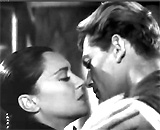
|
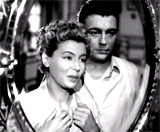
|
|
Orphee's Love for the Princess
|
Heurtebise with Eurydice
|
- Orphee was advised by Death's chauffeur Heurtebise,
a faithful guide, about how to enter the underworld - through his
bedroom mirror-portal - to return Eurydice to life, after she had
been struck down while riding her bicycle (off-screen) - she had
been killed by the Princess's leather-clad motorcycle men and taken
to the underworld: (Heurtebise "I am letting you into the
secret of all secrets, mirrors are gates through which death comes
and goes. Moreover if you see your whole life in a mirror you will
see death at work as you see bees behind the glass in a hive")
|
Heurtebise Instructing Orphee About Passage Into
the Underworld
|

|

|
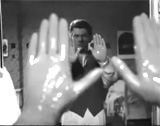
|
|
Orphee Passing Through Glass Mirror Into Underworld
|
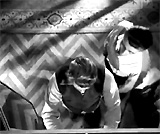
|
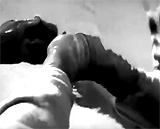
|

|
- the trick-shot scenes (some with reversed photography)
were of Orphee's crossing into the dreamy underworld to reclaim
Eurydice; Orphee passed himself through a glass mirror (representing
the borderline between life and the underworld); he first donned
a pair of latex surgical gloves (left behind by the Princess) -
that miraculously flew onto his hands - and then extended his magic
gloved hands through the mirror [Note: the scene was accomplished
by the actor putting his gloved hands into a vat of mercury (representing
the glass mirror) and then walking through or into the
mirror]
- the underworld scene in which Orphee was brought before
a tribunal panel of judges for interrogation; the Princess was forced
to admit the reason for taking Eurydice (and breaching her authority)
- her love for Orphee: "To get her out of the way and have this
man for yourself"; their decision was that Eurydice would be
returned with him, but only if he never looked upon her again
- the shocking moment that Orphee caught a brief glimpse
of Eurydice via the rear-view mirror of the Rolls Royce, causing
her to immediately disappear; shortly later, Orphee was killed when
accidentally shot by a member of an accusatory mob outside his home
(for allegedly murdering Cegeste)
- in the film's resolution, Orphee returned to the afterworld
with Heurtebise, but was again sent back to the living world (by
walking backwards in reverse) to be with Eurydice, with their memories
erased; the "immortal poet" would soon become a father
with his first child with Eurydice
|
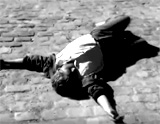
Death of Cegeste Outside Poet's Cafe in Paris
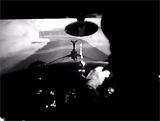
During Drive to Chateau - Outside Background Was "Negative" Image
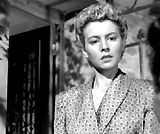
Orphee's Wife: Eurydice (Maria Dea)

Personification of Death: The Princess
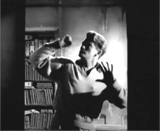
Orphee - Blocked From Passing Through Mirror to Underworld

Eurydice - Orphee's Dead Wife
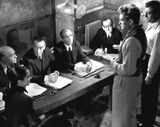
Orphee Before the Underworld Tribunal
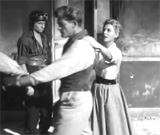
Orphee and Eurydice Returning to the Living World
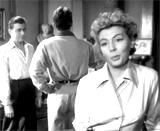
But Unable to Look at Each Other

The Glimpse of Eurydice in Rear-View Mirror - Causing
Her to Disappear
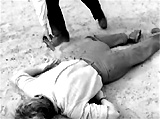
Orphee Shot and Killed
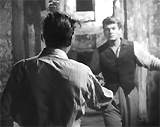
In the Underworld, Orphee Was Returned to the Real World
Again

Orphee's Happy Ending with Eurydice
|














